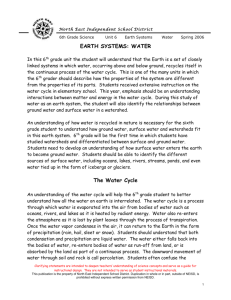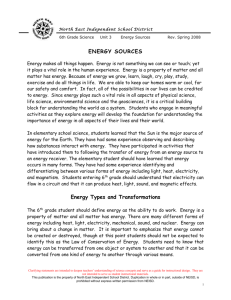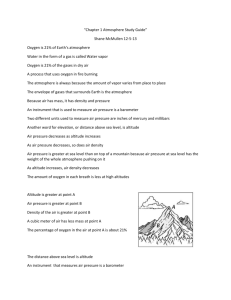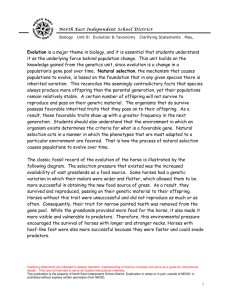6th grade Earth Atmosphere - North East Independent School District
advertisement
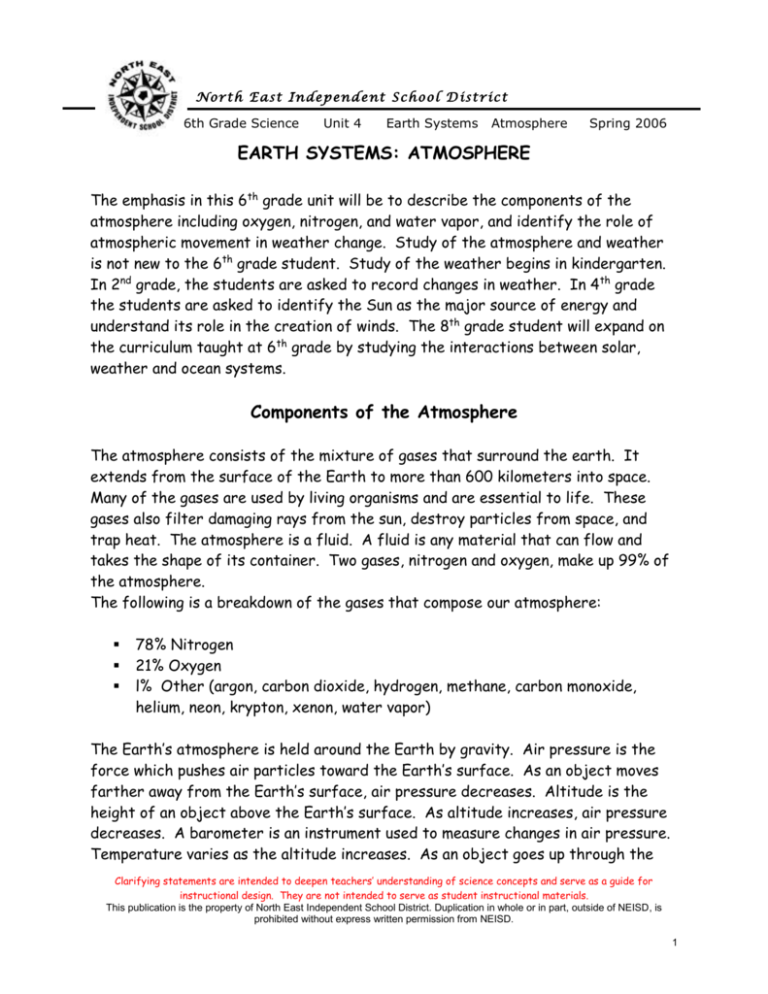
N o r t h E a st I n d ep en d e nt S c h o o l D i st ric t 6th Grade Science Unit 4 Earth Systems Atmosphere Spring 2006 EARTH SYSTEMS: ATMOSPHERE The emphasis in this 6th grade unit will be to describe the components of the atmosphere including oxygen, nitrogen, and water vapor, and identify the role of atmospheric movement in weather change. Study of the atmosphere and weather is not new to the 6th grade student. Study of the weather begins in kindergarten. In 2nd grade, the students are asked to record changes in weather. In 4th grade the students are asked to identify the Sun as the major source of energy and understand its role in the creation of winds. The 8th grade student will expand on the curriculum taught at 6th grade by studying the interactions between solar, weather and ocean systems. Components of the Atmosphere The atmosphere consists of the mixture of gases that surround the earth. It extends from the surface of the Earth to more than 600 kilometers into space. Many of the gases are used by living organisms and are essential to life. These gases also filter damaging rays from the sun, destroy particles from space, and trap heat. The atmosphere is a fluid. A fluid is any material that can flow and takes the shape of its container. Two gases, nitrogen and oxygen, make up 99% of the atmosphere. The following is a breakdown of the gases that compose our atmosphere: 78% Nitrogen 21% Oxygen l% Other (argon, carbon dioxide, hydrogen, methane, carbon monoxide, helium, neon, krypton, xenon, water vapor) The Earth’s atmosphere is held around the Earth by gravity. Air pressure is the force which pushes air particles toward the Earth’s surface. As an object moves farther away from the Earth’s surface, air pressure decreases. Altitude is the height of an object above the Earth’s surface. As altitude increases, air pressure decreases. A barometer is an instrument used to measure changes in air pressure. Temperature varies as the altitude increases. As an object goes up through the Clarifying statements are intended to deepen teachers’ understanding of science concepts and serve as a guide for instructional design. They are not intended to serve as student instructional materials. This publication is the property of North East Independent School District. Duplication in whole or in part, outside of NEISD, is prohibited without express written permission from NEISD. 1 N o r t h E a st I n d ep en d e nt S c h o o l D i st ric t 6th Grade Science Unit 4 Earth Systems Atmosphere Spring 2006 atmosphere, the air temperature changes from warm and cold depending on what gases are present in the layer and how those gases absorb the sun’s energy. Layers of the Atmosphere Name of Layer Troposphere Altitude in (km) (0-16 km) Characteristics of the layer Stratosphere (16 km – 50 km) Mesophere (50 km – 90 km) Thermosphere (Ionosphere)lower part (90 km – 300 km) Exosphere (300 km – 600 km) Layer nearest Earth All weather happens here More than half of the total mass of the atmosphere within this layer Temperature drops as altitude increases Most jets fly in this layer Protective ozone layer is at the top of this layer Jet stream is in this layer Temperature goes up with altitude Meteors burn up here Radio waves reflect to earth in this layer This is the coldest layer Auroras happen in the lower part of this layer Hottest layer in the atmosphere Satellites orbit in this layer Outermost layer Temperature goes up with altitude Clarifying statements are intended to deepen teachers’ understanding of science concepts and serve as a guide for instructional design. They are not intended to serve as student instructional materials. This publication is the property of North East Independent School District. Duplication in whole or in part, outside of NEISD, is prohibited without express written permission from NEISD. 2 N o r t h E a st I n d ep en d e nt S c h o o l D i st ric t 6th Grade Science Unit 4 Earth Systems Atmosphere Spring 2006 The Role of Atmospheric Movement in Weather Change Students in the 6th grade study weather while students in 8th grade will study both weather and climate. While weather changes from day to day in a local area, climate is a region’s general pattern of weather over a long period of time. The weather of an area is due to four atmospheric factors: heat energy, air pressure, winds, and moisture. The atmosphere is heated by radiant energy from the sun. The 6th grade student should have an understanding of the methods in which heat energy is transferred between objects to build a bridge to understanding movement within the atmosphere. There are three types of heat transfer: conduction, convection and radiation. Radiation is the transfer of energy or heat as waves. Radiation can occur in outer space where there are no moving molecules. This is the form of energy that brings the heat of the sun to earth. Conduction is the transfer of heat through direct contact. A hot sidewalk will warm bare feet through conduction. Convection is the transfer of heat in a fluid through currents. As air is heated, it becomes less dense and rises. Cool air is denser and sinks. This creates a circular pattern of air movement. Wind or air masses illustrate this type of heat transfer. Warm or cool ocean currents are another example of convection. Clarifying statements are intended to deepen teachers’ understanding of science concepts and serve as a guide for instructional design. They are not intended to serve as student instructional materials. This publication is the property of North East Independent School District. Duplication in whole or in part, outside of NEISD, is prohibited without express written permission from NEISD. 3 N o r t h E a st I n d ep en d e nt S c h o o l D i st ric t 6th Grade Science Unit 4 Earth Systems Atmosphere Spring 2006 Air pressure occurs as a result of the weight of the air pressing down on the Earth. A change in air pressure usually indicates a change in weather is going to occur. A body of air that has similar temperature, humidity, and air pressure is called an air mass. An air mass with low pressure is likely to be stormy. An air mass with high pressure is likely to be fair. Air moves from areas of high pressure to areas of low pressure. This movement occurs as the differences in air pressure cause wind. Winds generally blow from the poles, an area of higher air pressure, toward the equator, an area of lower air pressure. Winds move air masses that are classified by temperature and humidity. Air masses that form over oceans are moist. Air masses that form over continents are dry. The nearer a forming air mass is to the poles, the colder it will be. The nearer a forming air mass is to the equator, the warmer it will be. A front is where two air masses collide. Clarifying statements are intended to deepen teachers’ understanding of science concepts and serve as a guide for instructional design. They are not intended to serve as student instructional materials. This publication is the property of North East Independent School District. Duplication in whole or in part, outside of NEISD, is prohibited without express written permission from NEISD. 4 N o r t h E a st I n d ep en d e nt S c h o o l D i st ric t 6th Grade Science Unit 4 Earth Systems Atmosphere Spring 2006 The four types of fronts are classified on the following chart. Students in 6th grade should be able to explain the results of interaction between two different air masses. At this level, conceptual understanding of how this relates to changes in weather is more important than memorizing the types of fronts. It is also important for teachers to integrate how the properties of matter influence the interaction between air masses, ie. density differences. Clarifying statements are intended to deepen teachers’ understanding of science concepts and serve as a guide for instructional design. They are not intended to serve as student instructional materials. This publication is the property of North East Independent School District. Duplication in whole or in part, outside of NEISD, is prohibited without express written permission from NEISD. 5 N o r t h E a st I n d ep en d e nt S c h o o l D i st ric t 6th Grade Science Unit 4 Earth Systems Atmosphere Spring 2006 Scientists that study weather and the atmosphere are called meteorologists. Students are familiar with local news meteorologists that present the weather, using various maps. In addition, the daily newspaper provides such maps. Students should be given frequent opportunities to interpret weather maps and symbols using various resources. In addition, students should be exposed to different kinds of weather maps. Some show cloud cover or precipitation through satellite or radar. Others use various colors to depict temperatures. Surface charts combine many of these features, showing high and low pressure systems, precipitation on radar, and fronts. The diagram below depicts just one example of a map that students should be able to interpret: Clarifying statements are intended to deepen teachers’ understanding of science concepts and serve as a guide for instructional design. They are not intended to serve as student instructional materials. This publication is the property of North East Independent School District. Duplication in whole or in part, outside of NEISD, is prohibited without express written permission from NEISD. 6



